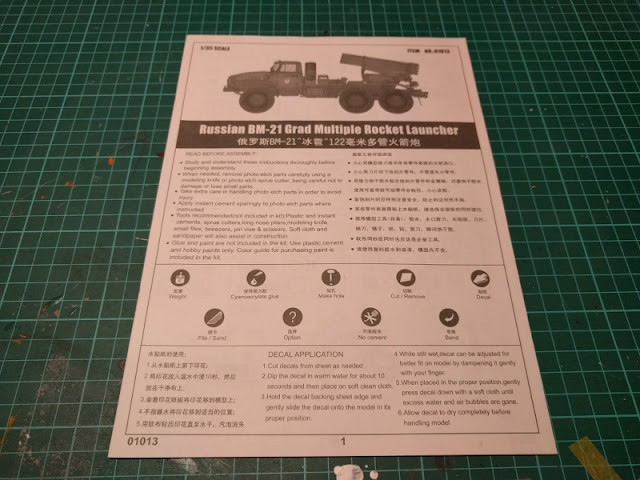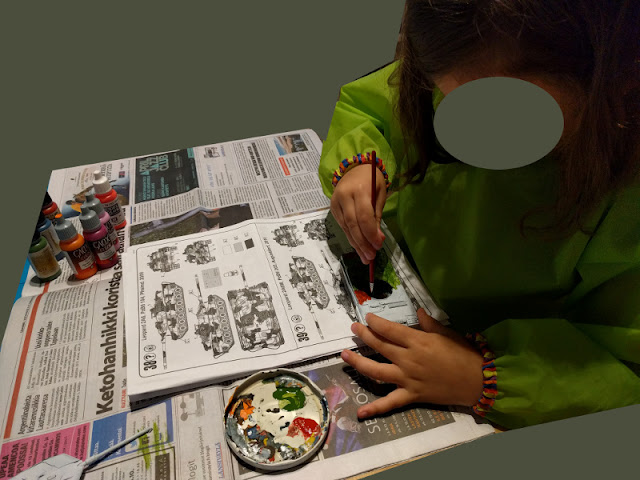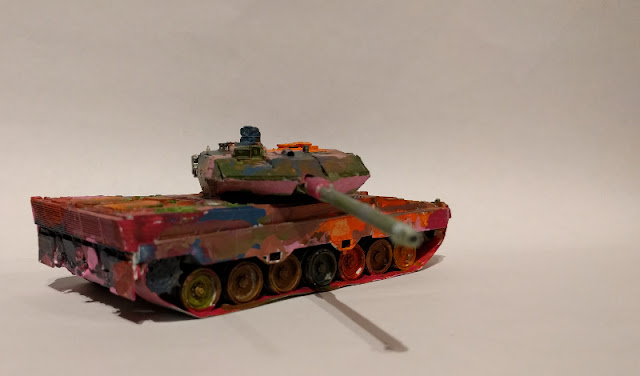The cabin and the controls
Last time I got just about finished with the framework, this time I glued on the last missing pieces. That included the steering system's attachments to the front wheels, both of which were three-piece monstrosities but attached very nicely to the wheel cores and as expected, locked them straight. That wasn't an issue as I wasn't planning on doing a diorama.After all this tiny stuff it was nice to get to do some broader strokes, so to say. I assembled the seats to the cabin. Of course the pedals were tiny, but not problematically so.
You couldn't really tell by the photo, but the back wall of the cabin was built out of two pieces. Luckily the rear glass pane (and all the other glass panes int this kit) were to be installed from the outside, instead of being sandwiched between the wall pieces. This allowed me to leave all the windows off without a care until I was done with the painting. And I didn't have to mask them both in and out, either.
The driver received a very flimsy-looking steering wheel, a handbrake handle, the gear shift lever and the aforementioned pedals. That stick that was installed in front of the map reader didn't really say anything to me, but I assumed that it had something to do with the rocket launcher's controls. That or the Soviet view on user (driver) ergonomy was on par with the British one...
A ridiculous number of tiny knobs, dials and PE bits were to be installed on the dashboard. Luckily I had no fitting issues with them and each settled in perfectly. There was also a decal for the dashboard but there was no way in hell I was going to use it here.
A curious control box was to be installed on the middle of the dash, just in front of the middle beam of the windshield, I guess I could've built it open but I went with the instructions and left it shut. There was also a complicated setup that was installed on top of what should be the glove compartment, in front of the map reader. I assumed it to have something to do with aiming the rocket launcher itself.
At this point I decided that I'd assemble the cabin as far as I could without severly crippling my ability to paint its insides, so I was going to leave the doors and the roof off for a while still. My idea was to minimize the amount of shadows, considering the paintjob, but also to minimize the post-painting gluings. Maybe I found a good balance point and maybe I just cocked it up, we'd find that out soon enough.
Getting outside
At this point I was quite pleased with the two-part setup for the doors. Thanks to my strong pareidolia I was very amused with the right end of the inner part of the door, as I saw an amusingly horrified face.Before anything was too far done I dry-fitted the doors into their slots (so I'd see if something was skewed wrong) and just for the fun of it I laid the whole setup on the framework. It actually worked nicely, this'd go well in the end.
I really have to say that I liked the emount of details in the Trumpeter kit, but damn, did it make my progress slow. While gluing the different handles and levers to the doors I was thinking that I had worked on the Ural truck for over a couple of weeks, on and off, at my usual pace. No, this was most definitely not a "shake the box and you've got an assembled model in your hands"-like Tamiya, not by a long shot. But what's more fun than a set that offers you plenty to do?
 |
| I guess the lightning bolt shapes in the doors were to make the beast a bit faster-looking? |
Along with the rest of this I also glued on the previously ignored snorkel piece and a couple of climb-on handles to the back of the cabin. The side view mirrors I left for a later, safer moment, as I assumed that the installation of the cabin on the framework might end up being more violent than necessary. This way these flimsy-looking bits would not be in danger of being cracked off accidentally.


































































